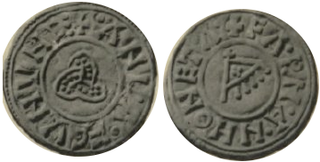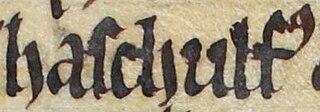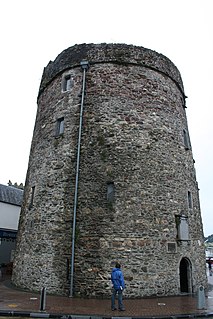
Amlaíb mac Sitric, commonly called Amlaíb Cuarán, was a 10th-century Norse-Gael who was King of Northumbria and Dublin. His byname, cuarán, is usually translated as "sandal". His name appears in a variety of anglicized forms, including Olaf Cuaran, Anlaf Sihtricson and Olaf Sihtricson, particularly in relation to his short-lived rule in York. He was the last of the Uí Ímair to play a major part in the politics of the British Isles.
Echmarcach mac Ragnaill was a dominant figure in the eleventh-century Irish Sea region. At his height, he reigned as king over Dublin, the Isles, and perhaps the Rhinns of Galloway. The precise identity of Echmarcach's father, Ragnall, is uncertain. One possibility is that this man was one of two eleventh-century rulers of Waterford. Another possibility is that Echmarcach's father was an early eleventh-century ruler of the Isles. If any of these identifications are correct, Echmarcach may have been a member of the Uí Ímair kindred.
Domnall mac Lorcáin, called Dómnall Claen or Domnall Clóen, was king of Leinster, the south-eastern province of Ireland.
Sitric Cáech or Sihtric Cáech or Sigtrygg Gále, was a Hiberno-Scandinavian Viking leader who ruled Dublin and then Viking Northumbria in the early 10th century. He was a grandson of Ímar and a member of the Uí Ímair. Sitric was most probably among those Vikings expelled from Dublin in 902, whereafter he may have ruled territory in the eastern Danelaw in England. In 917, he and his kinsman Ragnall ua Ímair sailed separate fleets to Ireland where they won several battles against local kings. Sitric successfully recaptured Dublin and established himself as king, while Ragnall returned to England to become King of Northumbria. In 919, Sitric won a victory at the Battle of Islandbridge over a coalition of local Irish kings who aimed to expel the Uí Ímair from Ireland. Six Irish kings were killed in the battle, including Niall Glúndub, overking of the Northern Uí Néill and High King of Ireland.

The Uí (h)Ímair, or Dynasty of Ivar, was a royal Norse-Gael dynasty which ruled much of the Irish Sea region, the Kingdom of Dublin, the western coast of Scotland, including the Hebrides and some part of Northern England, from the mid 9th century.

Ascall mac Ragnaill meic Torcaill, also known as Ascall Mac Torcaill, was the last Norse-Gaelic king of Dublin. He was a member of the Meic Torcaill, a Dublin family of significance since the early twelfth century.
Ragnall ua Ímair or Rægnald was a Viking leader who ruled Northumbria and the Isle of Man in the early 10th century. He was a grandson of Ímar and a member of the Uí Ímair. Ragnall was most probably among those Vikings expelled from Dublin in 902, whereafter he may have ruled territory in southern Scotland or the Isle of Man. In 917, he and his kinsman Sitric Cáech sailed separate fleets to Ireland where they won several battles against local kings. Sitric successfully recaptured Dublin and established himself as king, while Ragnall returned to England. He fought against Constantín mac Áeda, King of Scotland, in the Battle of Corbridge in 918, and although the battle was not decisive it did allow Ragnall to establish himself as king at York.
Gofraid ua Ímair or Guthfrith of Ivar was a Viking leader who ruled Dublin and briefly Viking Northumbria in the early 10th century. He was a grandson of Ímar and a member of the Uí Ímair. Gofraid was most probably among those Vikings expelled from Dublin in 902, whereafter he helped his kinsman Ragnall conquer Northumbria. Another kinsman, Sitric Cáech, became ruler of Dublin around the same time. Ragnall died in 920, and so the following year Sitric left Dublin to rule in Northumbria, and Gofraid succeeded Sitric as ruler of Dublin. Sitric's early reign was marked by raids he conducted against the native Irish, including one at Armagh.

Ivar of Waterford was the Norse king of Waterford from at least 969 until his death in the year 1000, and also reigned as King of Dublin, possibly from 989 to 993, and certainly again for less than a year between 994 and 995, returning after his expulsion from the city in 993 by Sigtrygg Silkbeard, who would expel him for good the next time.
Earl Ottir, also known as Ottir the Black, was a jarl who occupied a prominent position among the Norse of Britain and Ireland in the early 10th century. He is believed to be the founder of the settlement, Veðrafjǫrðr in the year 914. From 917 to his death in 918 Ottir was a close associate of the powerful overking Ragnall ua Ímair, although they are not known to have been related.
Cacht ingen Ragnaill was the queen of Donnchad mac Briain, from their marriage in 1032 to her death in 1054, when she is styled Queen of Ireland in the Irish annals of the Clonmacnoise group: the Annals of Tigernach and Chronicon Scotorum. Her husband himself, though King of Munster, is not widely regarded as having been High King of Ireland and so the extent of Cacht's influence is uncertain. That her style is superior to his presents an obviously strange situation in medieval Gaelic Ireland's male-dominated politics.
Ragnall mac Gofraid was King of the Isles and likely a member of the Uí Ímair kindred. He was a son of Gofraid mac Arailt, King of the Isles. Ragnall and Gofraid flourished at a time when the Kingdom of the Isles seems to have suffered from Orcadian encroachment at the hands of Sigurðr Hlǫðvisson, Earl of Orkney. Gofraid died in 989. Although Ragnall is accorded the kingship upon his own death in 1004 or 1005, the succession after his father's death is uncertain.

Gofraid mac Amlaíb meic Ragnaill was a late eleventh-century King of Dublin. Although the precise identities of his father and grandfather are uncertain, Gofraid was probably a kinsman of his royal predecessor, Echmarcach mac Ragnaill, King of Dublin and the Isles. Gofraid lived in an era when control of the Kingdom of Dublin was fought over by competing Irish overlords. In 1052, for example, Echmarcach was forced from the kingdom by the Uí Chennselaig King of Leinster, Diarmait mac Maíl na mBó. When the latter died in 1072, Dublin was seized by the Uí Briain King of Munster, Toirdelbach Ua Briain, a man who either handed the Dublin kingship over to Gofraid, or at least consented to Gofraid's local rule.

Ímar mac Arailt was an eleventh-century ruler of the Kingdom of Dublin and perhaps the Kingdom of the Isles. He was the son of a man named Aralt, and appears to have been a grandson of Amlaíb Cuarán, King of Northumbria and Dublin. Such a relationship would have meant that Ímar was a member of the Uí Ímair, and that he was a nephew of Amlaíb Cuarán's son, Sitriuc mac Amlaíb, King of Dublin, a man driven from Dublin by Echmarcach mac Ragnaill in 1036.

Ragnall mac Torcaill was a twelfth-century Norse-Gaelic magnate who may have been King of Dublin. He was a member of the Meic Torcaill, and may be identical to a member of this family who campaigned in Wales in 1144. Ragnall was slain in 1146, with some sources styling him king in records of his demise. He was the father of at least one son, Ascall, a man who certainly reigned as king.
The Battle of Islandbridge, also called the Battle of Áth Cliath, took place on 14 September 919, between a coalition of native Irish, led by Niall Glúndub, overking of the Northern Uí Néill and High King of Ireland, and the Dublin-based Vikings of the Uí Ímair, led by Sitric Cáech. It was one in a series of battles initiated by the native Irish to attempt to drive the Vikings of the Uí Ímair from Ireland. The battle was a decisive victory for Sitric Cáech and the Uí Ímair, with Niall Glúndub and five other Irish kings dying in the battle.
The Battle of Mag Femen took place on 22 August 917 between the Vikings of the Uí Ímair, led by Ragnall, a grandson of Ímar, and the Irish of the Northern Uí Néill, led by Niall Glúndub, High King of Ireland. It was one of two battles involving the Uí Ímair that year, the other being the Battle of Confey, which occurred as a result of the Uí Ímair trying to retake the Kingdom of Dublin which they had lost in 902. The battle began when Niall Glúndub's forces attacked a Viking army at a site identified by the annals as Topar Glethrach in Mag Femen. The Irish initially inflicted the majority of the casualties, but late in the day a host of more troops led by Ragnall reinforced the Viking army, securing victory for the Uí Ímair.
The Meic Torcaill, also known as the Meic Turcaill, the Mac Torcaill dynasty, the Mac Turcaill dynasty, and the Mac Turcaill family, were a leading Norse-Gaelic family in mediaeval Dublin. The kindred produced several eminent men and kings of Dublin before the English conquest of the kingdom in 1170. Afterwards the family fell from prominence, losing possession of their extensive lands in the region. In time the Meic Torcaill lost precedence to other Dublin families, such as the Harolds and Archbolds.
Ragnall ua Ímair, also known as Ragnall mac Ragnaill, was an eleventh-century King of Waterford. He appears to have ruled as king from 1022 to 1035, the year of his death.
Lagmann mac Gofraid may have been an early eleventh-century ruler of the Kingdom of the Isles. He seems to have been a son of Gofraid mac Arailt, King of the Isles, and was likely a member of the Uí Ímair kindred. According to mediaeval sources, Lagmann was closely associated with Óláfr Haraldsson, a future King of Norway. According one source, both men lent assistance to Knútr, son of Sveinn Haraldsson, King of Denmark, although it is possible that this account actually refers to Óláfr's campaigning in England several years beforehand. Lagmann and Óláfr are also recorded to have assisted Richard II, Duke of Normandy. The two are specified to have not only ravaged lands in Brittany on behalf of Richard, but were tasked to counter Richard's opponent Odo II, Count of Chartres. Lagmann's activities on the Continent may have arisen as a result of being forced from the Isles following the death of his possible brother Ragnall mac Gofraid, King of the Isles in 1004 or 1005. Lagmann's son, Amlaíb, is recorded to have perished at the Battle of Clontarf in 1014. If Lagmann died at about this time as well, it could account for the record of Hákon Eiríksson assuming control of the Isles.








